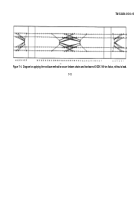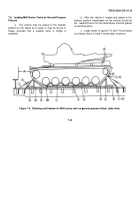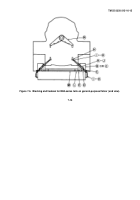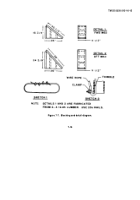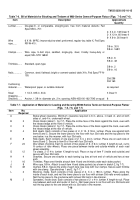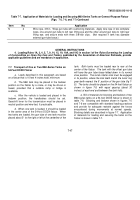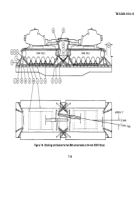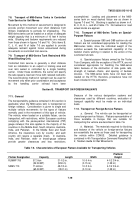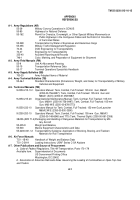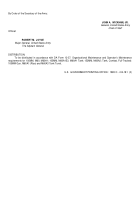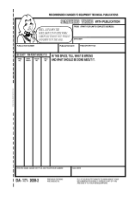TM-55-2350-215-10-15 - Page 60 of 66
TM 55-2350-215-10-15
7-8.
Transport of M60-Series Tanks in Controlled
Train Service for Unit Moves
Movement by this method of securement is designed to
provide prompt movement over short distances from
military installations to portside for shiploading.
The
M60-series tanks can be loaded on a railcar of adequate
weight capacity that is a minimum of 10 feet 4 inches
wide.
Blocking and tiedown requirements are reduced
from those shown in figures 7-5 and 7-6.
Only items B,
C, J, K, and N of table 7-5 are applied to provide
adequate restraint against forces encountered during
movements on controlled train service.
7-9.
Transport of M60-Series Tank Restrained With
Wood Blocking Only
Controlled train service is generally a short distance
from an installation to an outport or training area and
over rails owned or controlled by a single handling
carrier.
Under these conditions, the carrier will specify
the safe speed a load can move with reduced restraints.
The wood blocking method of restraint can be used for
movement only when prior coordination and acceptance
by
the
handling
carrier
railroad
have
been
accomplished.
Loading and placement of the M60-
series tank on wood decked flatcar are as shown in
figures 7-5 and 7-6.
Blocking is applied as shown in A,
B, C, D, E, L, and M of table 7-5.
No tiedowns or road
wheel blocks are applied.
7-10.
Transport of M60-Series Tanks on Special-
Purpose Flatcars
a
.
Special-purpose G85 and G89 cushion rub-rail
flatcars are not considered appropriate for loading the
M60-series tanks, since the individual weight of the
vehicles exceeds the load-restraint capability of the
tiedown chains working in relation to the action of the
cushioned rub-rails.
b
.
Special-purpose flatcars owned by the Trailer
Train Company, with the exception of the HTTX, are not
considered appropriate for handling the M60-series
tanks because of the obstruction of side guide rails,
strength of tiedown chains, and spacing of tiedown
devices.
The M60-series tanks have not been test-
loaded on the HTTX; therefore, procedures have not
been included in this publication.
Section III.
TRANSPORT ON FOREIGN RAILWAYS
7-11.
General
The transportability guidance contained in this section is
applicable when the M60-series tank is transported on
foreign railways.
Consideration is given to single and
multiple vehicle movements for the types of flatcars
normally used in the movement of this type of vehicle.
The vehicle, when loaded on a suitable flatcar, can be
transported, with restrictions, within European countries
complying with the passe-partout international (PPI)
gauge railways; this also applies to the majority of the
countries in the Middle East, South America, Australia,
India, and Pakistan.
In the Middle East and South
America, the clearances vary by country, and each
country will require a separate check.
In Australia,
India, and Pakistan, wide- or broad-gauge railways
provide greater clearances and less restrictions.
Because of the various designation systems and
clearances used by different countries, evaluation of
transport capability must be made on an individual
basis.
7-12.
Transport on Foreign-Service Flatcars
a.
General
.
The vehicle can be transported on
some foreign-service flatcars.
Flatcars representative of
those available in Europe that are suitable for
transporting the vehicle are described in table 7-6.
b.
Materials
.
The materials required for blocking
and tiedown of the vehicle on foreign-service flatcars
are essentially the same as those used for transporting
the vehicle within CONUS.
Detailed guidance is
contained in 4th Transportation Command Pamphlet 55-
2,
Tiedown Guide for Rail Movements.
Table 7-6.
Characteristics of European Flatcars Available for Transporting Vehicles
Platform
Flatcar Designation
Capacity
Length
Width
Height
RLMMP 700
57.3-ton
31-ft 2-in.
10-ft 4-in.
4-ft 2 3/4-in.
(52.00 MT)
(9.50 m)
(3.15 m)
(1.29 m)
SAMS 710
71.63-ton
49-ft 3-in.
10-ft 2-in.
4-ft 2 3/4-in.
(65.00 MT)
(15.01 m)
(3.10 m)
(1.29 m)
7-19
Back to Top



